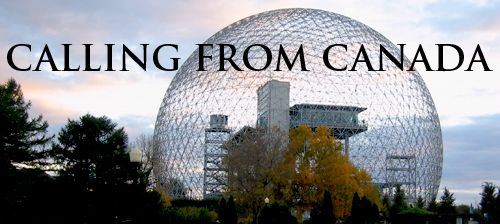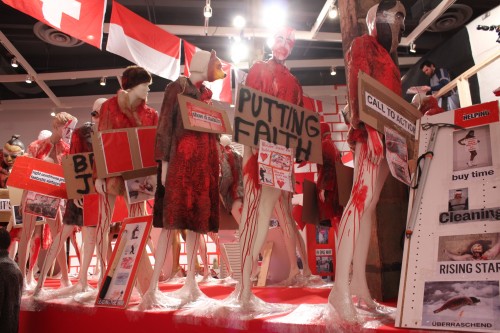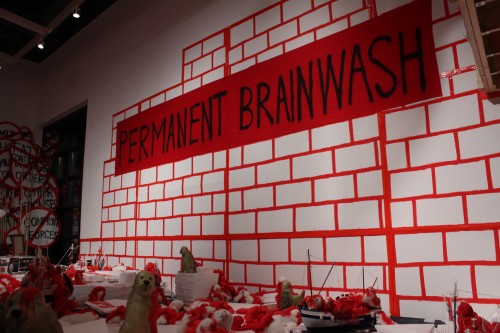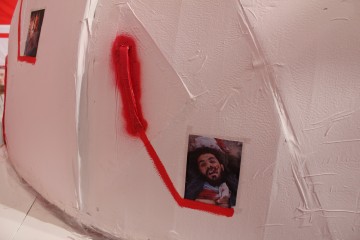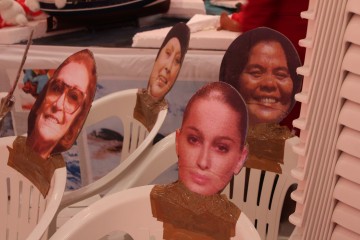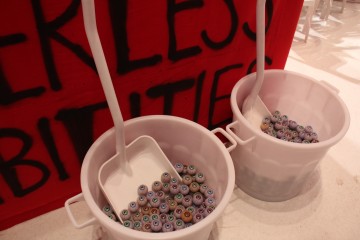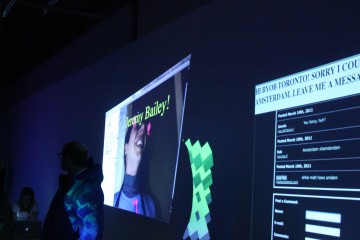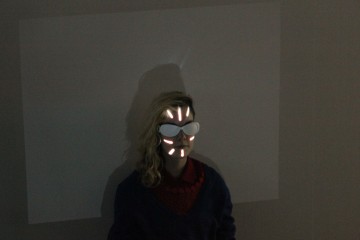I recently made the trip from Montréal to Toronto – clocking in over six hours of driving on the dismal 401 Highway in my packed rental car. In the backseat were artist friends participating in the Toronto version of BYOB, or Bring Your Own Beamer. I was making the great sojourn in part to also attend BYOB, but primarily to attend the hyped reopening of Toronto’s snazzy Power Plant art gallery and its unveiling of Swiss artist Thomas Hirschhorn’s Das Auge (The Eye). Two shows on the opposite sides of town, on the opposite sides of the spectrum.
Imagine a giant room in one of Toronto’s most important galleries overtaken by the colors red and white; squirted, splurged, and oozed fake blood is dried all over objects in the room. From stuffed animal baby seals and real fur coats covered in red paint, to groups of Coke bottles and hanging red and white country flags, to white lawn chairs affixed with celebrity face cutouts, to newspaper clippings of war atrocities, walking through the room feels like making your way through a physical collage: a child’s giant school project, a dioramic meditation on war and consumerism, pulled together with packing tape. Small mountains of objects pulled from their usual context – mannequins that belong in store windows, studio wigs from salons etc., are mixed with the decidedly cheap materials you may see on the curb on garbage day – their golden homes are broken plasterboard, chunks of Styrofoam, excessive amounts of duct tape.
According to the press release, “The exhibition is based around the image of an eye that sees only the colour red.” Indeed, the magnitude of the room and the cacophony of materials that comprise it are overwhelming, but then so is a cafeteria full of screaming kids at lunch hour. It better be more than just a loud mess for the admission price. Even Hirschhorn, a former graphic designer, admits his art aims are not aesthetic and claims that they are not didactic nor political either. And so when the production of the artwork is intentionally big, over-the-top, and scatological, and its aims are neither aesthetic nor educational, what remains? Hitting-the-nail-on-the-head with overtly political imagery and deliberate “excessive excessiveness” happens so hard in this case that the proverbial nail is obliterated. Vanished. There is no more nail, Hirschhorn.
At one point during my visit, an entire press package was accidentally dropped from where someone was standing on the second floor mezzanine onto the first. The press pack and its red and white contents landed right on top of part of the installation below, where dozens of white stuffed animal seals were grouped together. The contents of the press pack were strewn about, adding to the hodgepodge of the installation. I overheard one couple as they wandered by the strewn press release materials (believing that they were placed there intentionally as part of the exhibition), remark something along the lines of, “It’s like, a commentary on how the gallery and even the press is implicated in this violence and globalization.” Mmm hmm. The” anything goes” look in an installation is only slightly troubling, but the lack of quality in Hirschhorn’s work is something he has famously championed. The Eye attempts to present a vision analogous with how inundated we are today with violent imagery but falls short the same way that my response to judges of my fourth-grade science project on static electricity fell short. Energy? Yes! Quality? No. The attraction-repulsion dynamic can be productive or even humorous – take for example, Dinos and Jake Chapman’s pseudo, at times comically gory Fucking Hell, where conceptual depth meets artistic competence in the actualization of the artwork. The artwork, however, ought to be compelling on the level of valuing ideas and/or production, but not neither.
Funnily enough, the artist friend who accompanied me to the Hirschhorn exhibit currently makes her living working with props; she kept letting out these low whistles, exclaiming, “Wow, you know how much those cost?!” pointing to containers of glass eyeballs and continuing, “a fortune! And he uses so many of them! …and these mannequins?!” Of course, she was commenting on the resources (ahem, budget!) an artist of Hirschhorn’s reputation and stature commands. My friend pointed out that though Hirschhorn claims to use inexpensive materials, and while the display of these items may appear haphazardly done, to be fair, some of materials are anything but cheap. She was not decrying the disrespect or irreverence for materials, but more conceptual consideration given the bigness of it, stating, “I’ve seen less popular artists do much more with much less.” And the next day we found just that, across town at a small space called, Gallery TPW, where BYOB (Bring Your Own Beamer) took place.
Organized by self-proclaimed “Famous New Media Artist” Jeremy Bailey, Toronto’s installment of BYOB occurred as part of a series of BYOB’s initiated by Rafael Rozendaal. Simply put, “BYOB hosts artists and their projectors in one-night exhibitions.” The parameters are undefined and new media artists interpret and take full advantage of the limits of DIY tactics in an encouraging environment. Bailey’s live animated projection of himself demonstrates his use of basic software MAX/MSP/Jitter on his laptop to add visual icons and effects to the image of his face. In a conversation with Bailey, he disclosed that the act of projecting himself that large on a wall and putting out videos of himself online is a many-layered examination of white privileged masculinity and self-consciousness; his work grapples with the idea of managing one’s standard identity online, an increasingly unavoidable issue today. Artist Brad Tinmouth also addresses the idea of everyday celebrity with what seemed like a lackluster small projection behind a set-up of self-promotional items he was selling – perhaps a commentary on the very real issue (which many new media artists face) of how to monetize digital art and earn a living from intangible and/or reproducible or re-playable works. Natasha Bailey’s live typing on her MacBook Pro of a script of an “intervention” with her computer projected live onto the back of her white T-shirt is a play within a play and an example of the personification we attribute to technology, particularly our laptops, with whom it seems we communicate as often as we do with humans. Brett Bergmann‘s projections directly onto actual faces of willing visitors wearing covered glasses effectively turns individuals into screens and walls of digital information. There were two dozen artists in this exhibition and with so many video projections running at the same time in the same room, you’d be right to call it overwhelming, but in all the right ways.
After having visited a high-profile art show the night before, whose message resonated like the Emperor’s new clothes, it was exciting to experience a small show with huge ideas. Like the Hirschhorn exhibition, BYOB is also about globalization and even inhabits the sense of being thrown together in a similarly improvisational manner, but with far limited resources. BYOB Toronto managed to host original and conceptually complex works by two dozen artists in what is more-or-less a small white cube. Big ideas, small space. It was refreshing to see how each artist aesthetically handled ethical and social issues inherent in the digital age, and often with a welcomed, appropriately self-deprecating or comical edge. Where one artist had a relatively large budget to do (relatively) whatever he wanted, he chose to make his exhibition appear DIY, while in another instance, the BYOB artists used software to play with a crappy online and digital aesthetic that they slickly manipulated. I realize that in many ways, these shows are like comparing apples to oranges but nonetheless, it is satisfying to watch emerging artists, who are equally ideas-led as they are hands-on, so swiftly trump the celebrated and supreme storytellers with fresh, compelling, and relevant work.

